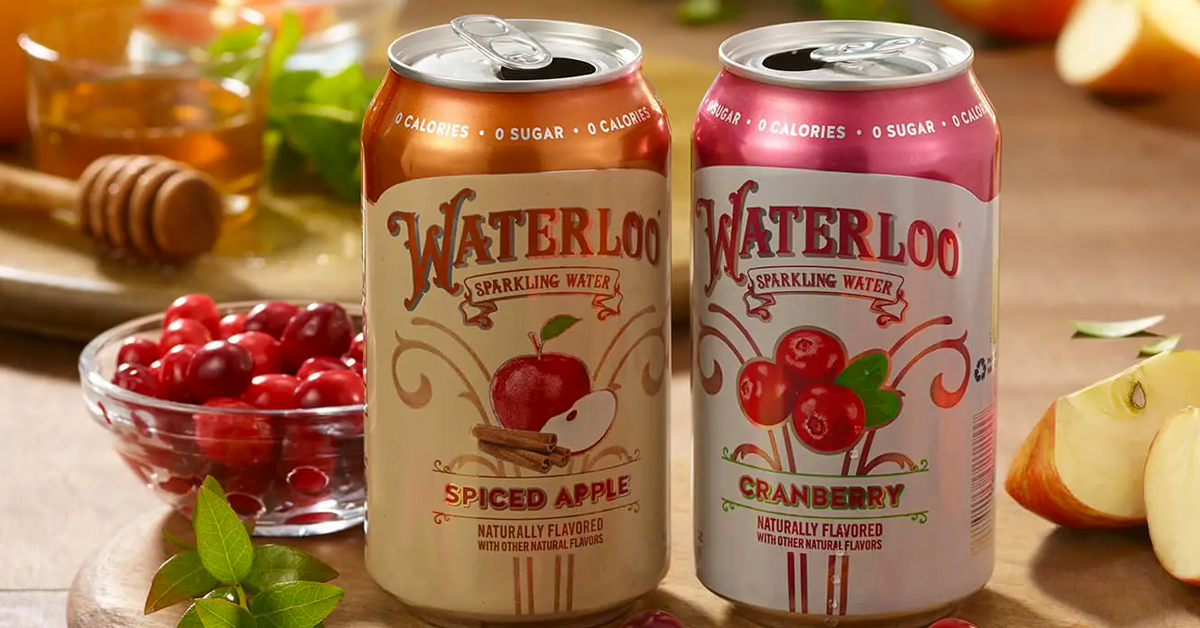
Waterloo has not yet met its Waterloo. In fact, it’s making more like early season Napoleon, conquering territory and building the empire.
We saw some movement in last month’s Nielsen survey that left us pretty interested in the ways that the brand, which sold a majority interest to investor group Eurazeo Brands, Flexis Capital, and Moore Strategic Ventures back in 2020, has solidified its momentum. Waterloo has hit about $150 million at retail, and is growing faster than any significantly-sized sparkling water brand, up 56% over the past year and 223% in the four-year stack, with Nielsen numbers dating back from July 29, according to the survey provided by Bonnie Herzog of Goldman Sachs Equity Research.
The only brand in that growth neighborhood is Spindrift ($188 million, up 30% in the past year and 230% in the past four), although both Polar and Talking Rain have each enjoyed strong 4-year arcs. The point is, that kind of growth takes money and it takes strategy, and on what turned out to be the three-year anniversary of their acquisition by the investor group, we had a quick talk with CEO Jason Shiver and CMO Kathy Maurella to find out what’s driving the growth.
“In three years, we’ve just about tripled our business,” Shiver started off by saying. “I think it’s kind of a really cool soundbite… the investors are very happy.”
With the first investment, Maurella said, the brand devoted money to buying research, adding Nielsen and a brand tracker to look at household penetration and loyalty. The numbers they like? “We have the fastest growing number of households buying the brand,” against the rest of their competitive set, Maurella said and “the incredible news is our loyalty continues to grow as we do this.”
The brand considers its competitive set as Polar, Aha, Bubly, LaCroix and Spindrift. They don’t think about Liquid Death as part of it as its core SKU is non-carbonated and the brand is positioned differently against the rest of the group, while Talking Rain is sweetened.
The growth helped attract a new set of investors. Shiver revealed that in the spring, Waterloo took in a minority investment of “tens of millions of dollars” to help fuel growth. Even with the brand performing well, however, it wasn’t easy; the brand partnered with Goldman Sachs and it required a rigorous valuation process.
“Let’s not fool anybody, this environment that we’re in, from a macroeconomic perspective… is the worst that I’ve seen,” Shiver said. “I fear that we’re going to see some bankruptcies coming up simply because the dollars just aren’t plentiful out there.”
Knowing that environment, Shiver looked at the raise as a building block for growth, but it was also insurance, he added, noting “we wanted to make sure that this company is buffered from some of these outside influences that we have no control over.”
But having that money in is useless if tactics and strategy aren’t in line. From retail, to keep the loyalty continuing beyond just the addition of new customers, Maurella said, the company instead marketed directly into its biggest distribution markets to reinforce growth, leaving social media and PR – like a campaign with Australian chef Curtis Stone – as national campaigns but diverting most of the dollars toward shopper marketing with key retailers and bringing back field marketing in those key sales areas.
“It was a three-pronged approach that had to be [satisfied] before that market got awareness marketing dollars. First, did you have enough ACV, was the category big enough there, and was there enough of our target consumer?”
Still, with room to grow in grocery and other spaces, convenience, where Coke and Pepsi have their own brands and KDP is aligned with Polar, remains a high barrier to entry for Waterloo, and could weigh on scale.
Despite Waterloo’s fast-growth in the brick and mortar business, if “you don’t have a DSD partnership, nationally, then… convenience is just going to be a pipe dream to some degree, unless you can get really creative on how you want to tackle it.”
Instead, they plan to look internationally and at food service, while also doubling down on the dotcom side of their retail universe. Notes Maurella, “across every major retailer in the country, is that this brand overindexes on their dotcom sales versus the category…. So there is clearly, within the retailer set we’re in, we know that’s an opportunity.”
Big exits are blocked, though, with the big soda companies paired off with their own products, creating the same problem Waterloo has with scaled distribution. So the brand has the size and momentum to look at exits, but it will have to find partners who know there’s probably another step or two before a massive sales return.
“Once a business gets up to a certain level, you know, we have to start looking in the mirror and saying, you know, are we up for this?” Shiver says.
Shiver took Skinnypop, his last big brand, through an IPO as part of Amplify brands, but the product type is different from a liquid, he said. Making it clear that there aren’t conversations or overtures, he added, “you really want to try to build this brand to where at any point, right, if there’s an exit, that is a mutually beneficial exit…. How we handle ourselves is to build a brand and if anybody down the road, whenever it is, you know, decided that, hey, we’ve love to, you know, pull in and plug this into a strategic operation, and we’re using that as an example, but that this brand is already set up to be hyper-successful for them.”
The brand recently promoted two key members of the executive committee as well: Brian Ponticello, who moved up to Chief Revenue Officer from SVP of sales, and David Ingraham, who became CFO – after helping scale growth and acting as the financial lead in the recent outside raise.